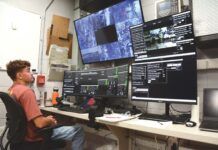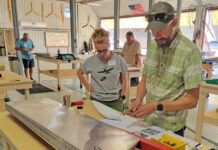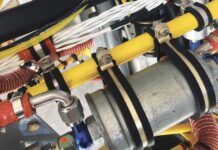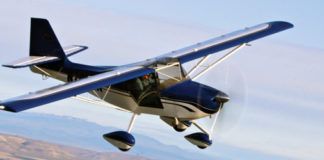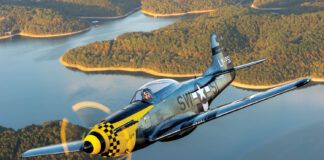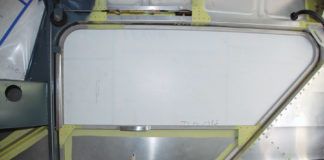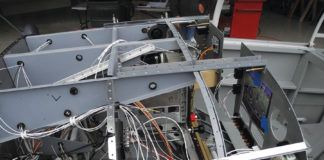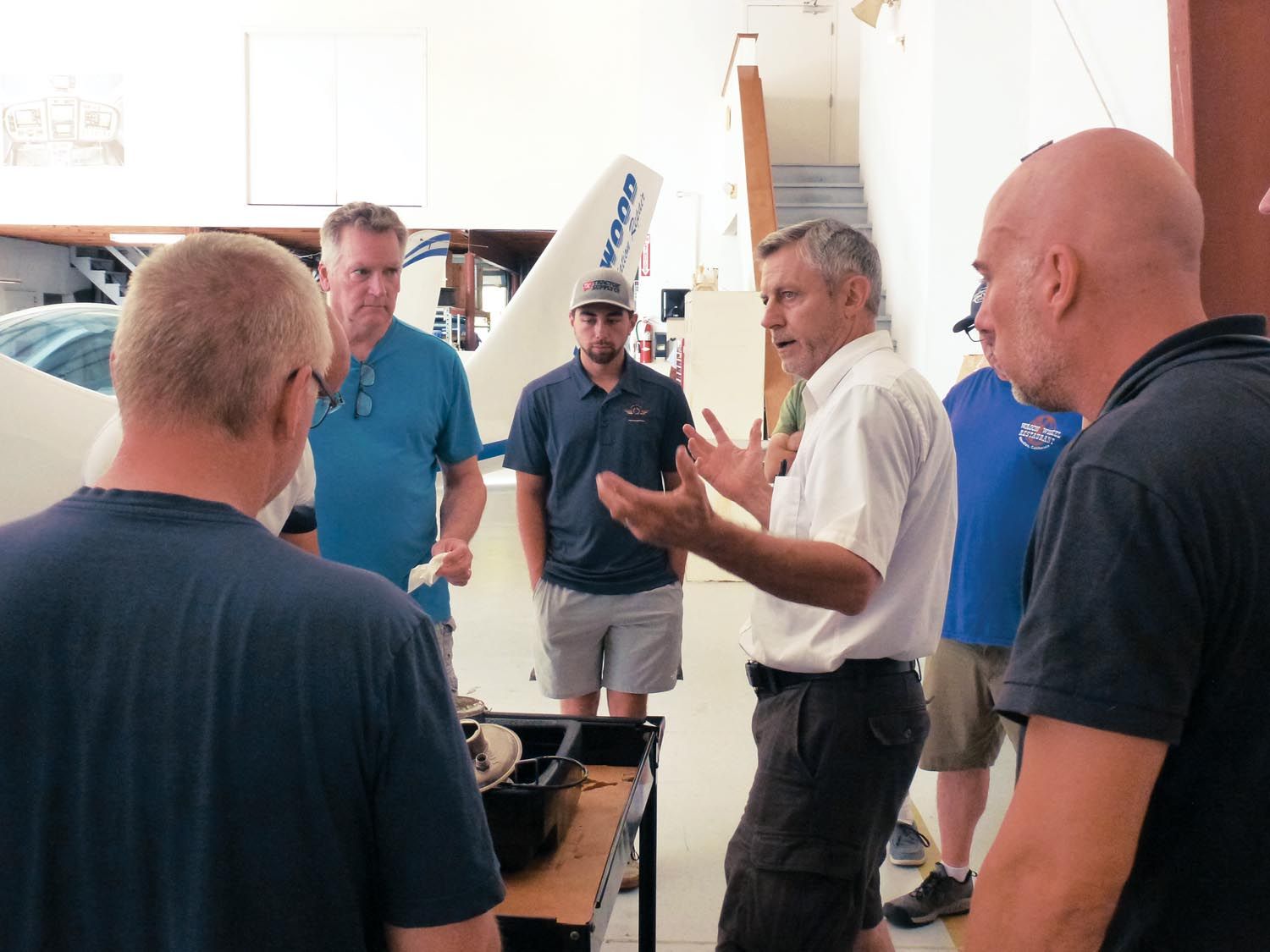 Thirteen years into my two-year SeaRey build, OspRey finally had its engine mounted. But when I signed on the dotted line for my new Rotax 914, and with little more knowledge than how to change the oil in my car, I was nervous about my abilities to maintain this expensive engine. Because of this, back in 2014, I attended a weeklong service and maintenance class at Canadian Rotax distributor Rotech Motor, Ltd. Thanks to an excellent hands-on instructor, who acted like he had all the time in the world and a bagful of instructor tricks to teach us, by the second afternoon I had dropped my skepticism and distrust of the price/power ratio of the Rotax engine and was (almost) ready to go out and get a Rotax tattoo.
Thirteen years into my two-year SeaRey build, OspRey finally had its engine mounted. But when I signed on the dotted line for my new Rotax 914, and with little more knowledge than how to change the oil in my car, I was nervous about my abilities to maintain this expensive engine. Because of this, back in 2014, I attended a weeklong service and maintenance class at Canadian Rotax distributor Rotech Motor, Ltd. Thanks to an excellent hands-on instructor, who acted like he had all the time in the world and a bagful of instructor tricks to teach us, by the second afternoon I had dropped my skepticism and distrust of the price/power ratio of the Rotax engine and was (almost) ready to go out and get a Rotax tattoo.
But a mind is a terrible thing to waste. It was nine years later when I finally purchased, unpacked and mounted my Rotax 914, and I found myself struggling to remember the lessons from the class. Rotech was a 5-hour drive from my house but there were no classes being offered until the fall. Luckily, the Rotax Flying and Safety Club (RFSC) is an authorized Rotax training organization, and their website (www.rotaxirmt.com) maintains a list of upcoming classes and locations around the world. Ultimately, I chose Lockwood Aviation in Sebring, Florida, from whom I had purchased my engine.
Three classes are offered. Service is designed for the basics you’d want as an owner/operator to change the oil, balance the carbs (more on that later) and perform scheduled maintenance. Maintenance is where you get to tear an engine down all the way short of pulling the flywheel or splitting the case in half. The third class, a single day, is dedicated to the fuel-injected engines.
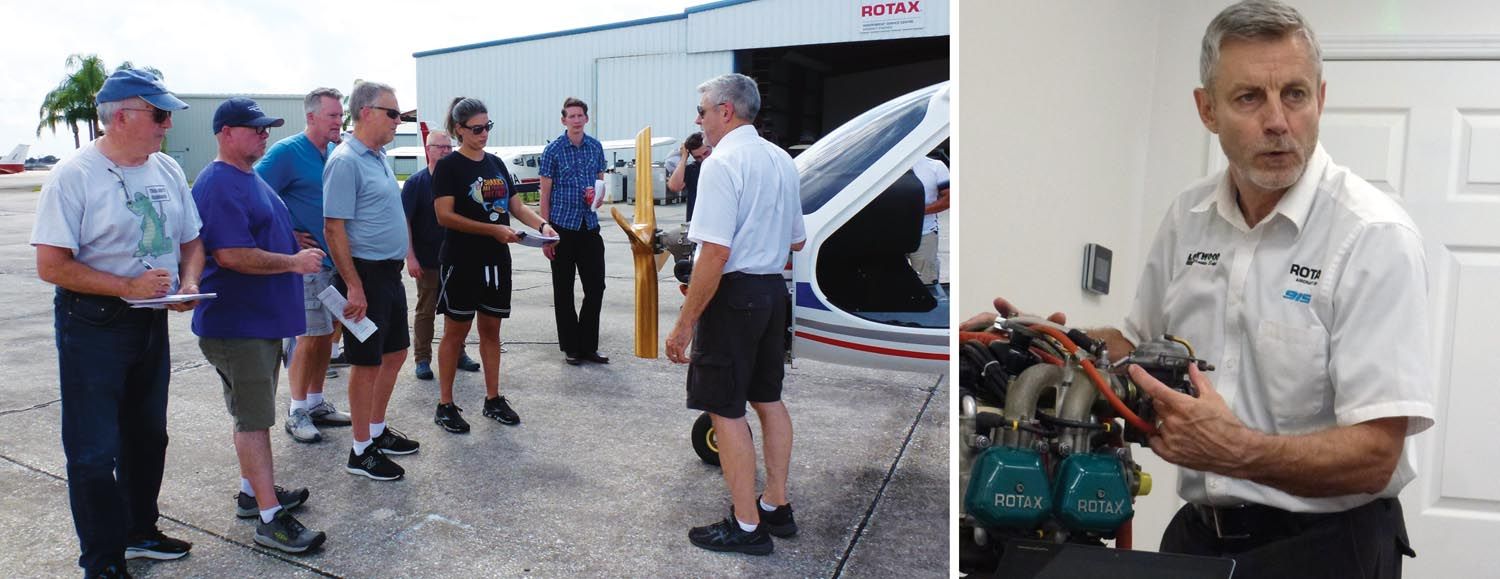
The Prep Work
A week before the class the instructor, Dean Vogel, emailed all of us links to a bunch of documentation, suggesting we familiarize ourselves with it. While I have a 914, the class documentation was all for the Rotax 912, but from the 2014 class I knew the engines were similar enough that about 95% of the material would be the same or similar. Plus when I called and registered for the class, Dean told me to prepare to stay late both days for some extra one-on-one instruction particular to my engine. The material Dean had us download was about what you’d expect: installation and parts manuals, light and heavy maintenance manuals, all stuff Dean said we’d need to take the test to pass the class. Wait, there’s a test? No one said anything about a test.
The classes are primarily designed for mechanics to get or renew their iRMT (independent Rotax Maintenance Training) certification, so recurrent training and testing is required biannually by Rotax to be listed as a certified Rotax mechanic and for access to current documentation. But the class is open to all, homebuilders and owners included. Dean recommends builders attend at least the service course, and I strongly agree with him. There’s nothing like getting excellent, in-person, hands-on instruction from a factory- trained expert to make you feel much better about what you can or can’t do with your engine.

Once On Site
You might be tempted to make the Sebring trip a working vacation by bringing the family down, but I’d advise against it because Sebring isn’t very close to Disney. However, there are several nice hotels in the area ranging up and down the luxury scale, and since it was the off-season I took advantage of an arrangement Lockwood has with the Seven Sebring Raceway Hotel, located on the seventh turn of the Sebring Raceway. It’s a short 5-minute drive or shuttle ride from Lockwood and I got a nice balcony room overlooking the racecourse at a surprisingly good rate because of this.
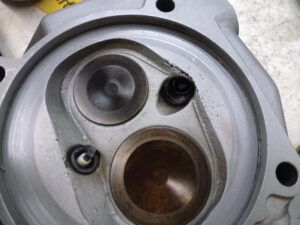
I had swapped emails before the class with Dean, who is a former F-15 pilot and was a key employee at Cirrus Aircraft before coming to Lockwood in 2006. In person, he appeared to be a grayed version of the Robert Patrick T-1000 in the Terminator 2 movie. A bit intimidating at first, he still has the cold, steely eyes of a fighter pilot, but I was relieved to find he had a wicked sense of humor and often punctuated classes with jokes and stories of terrible things people had done to engines in the past.
In the class, we had a wide mixture of male and female, professional and general aviation pilots, FBO mechanic/owners and mechanics sent by their schools, as well as another homebuilder like me. I felt a bit self-conscious taking the classes for the second time but Dean quickly reassured me that it was not uncommon and was a smart thing to do, reminding me that certified Rotax mechanics are required to take it every other year to stay current. He encourages builders to take the class both before and after acquiring their engines because (as I can attest) learning it on the school’s engine and then going back home and applying the knowledge to your own is a huge gulp moment.
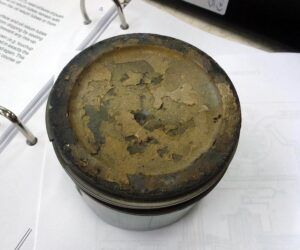
When you consider that the price of a mistake could easily be hundreds or even thousands of dollars and at worst loss of life, the cost to come to a class is trivial. In my case, tech support is now a bit easier when I call in for help since Dean and I have now gotten to know each other and, to be honest, I’ll probably take the class again or see if I can arrange a one-on-one visit before I run it for the first time. It’s cheaper than a ruined engine.
About the Engines
Rotax engines have more in common with motorcycle technology than legacy aircraft engines. This is not better or worse, just different, which of course, pilots hate. Rotax engines are higher revving and geared (like a Continental GTSIO-520 on a Cessna 421), liquid cooled (like a P-51 Mustang’s Merlin engine) and engineered for a higher power/weight ratio. They use a hybrid cooling system, with air-cooled cylinder barrels and liquid-cooled heads. Since the heads are liquid cooled there is no need for huge cooling fins on the cylinder heads, allowing the cylinders to be closer together and the engine to have a smaller frontal section. The liquid cooling of the cylinder heads also results in a more stable thermal environment for the heads.
One huge advantage is that the engine is designed to run on unleaded autogas. The Rotax will tolerate some use of 100LL, or you can use a fuel additive such as Decalin RunUp to help counter the lead in avgas, but this requires more frequent engine maintenance, not an ideal situation. Rotax owners are in a better place than those with high-compression legacy engines when it comes to an alternative to 100LL fuel. In fact, for the last eight years Lockwood has been running their engines exclusively on Swift’s 94-octane unleaded fuel—and the engines reportedly love it.
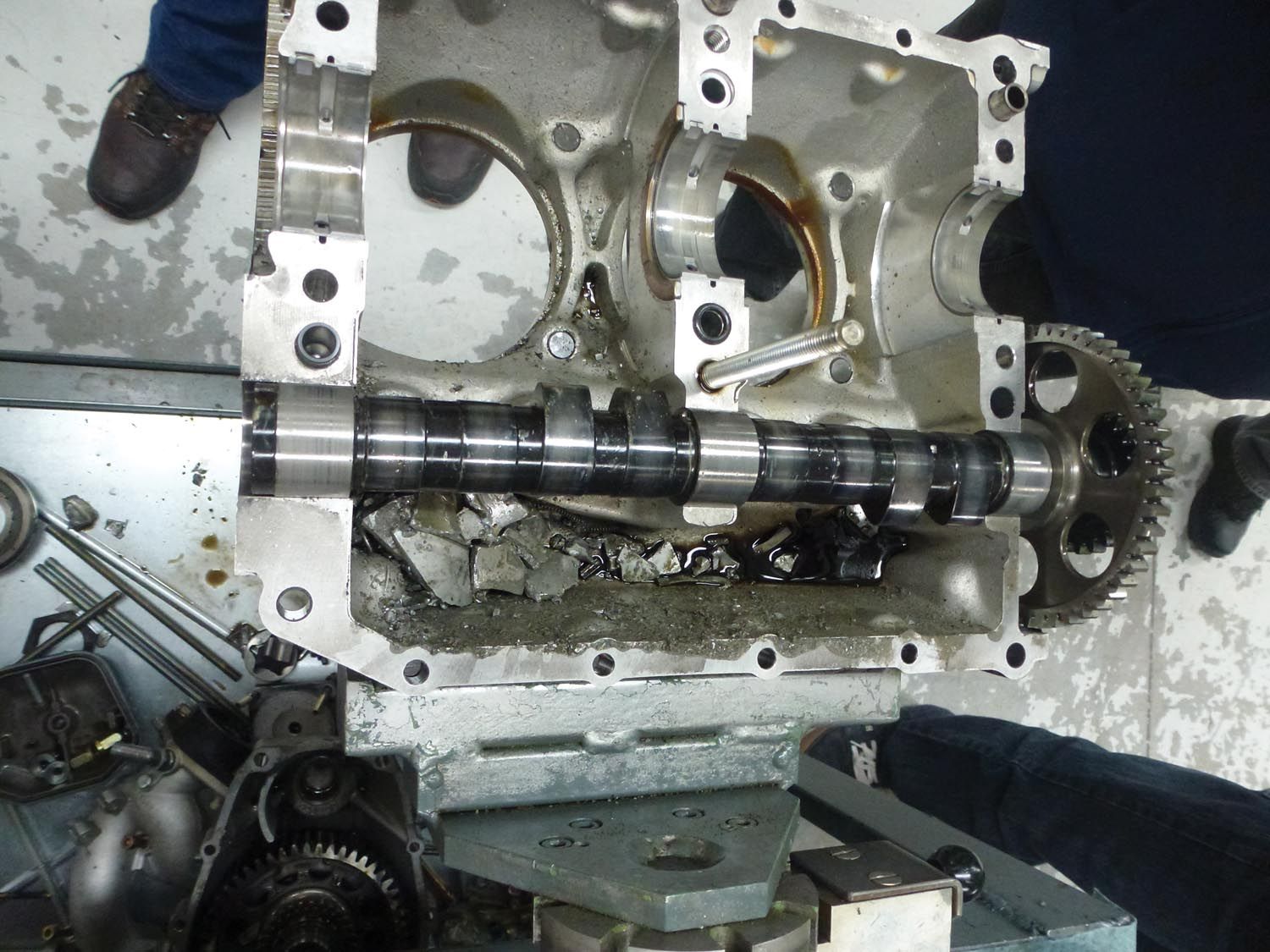
Course Work
There is no way I can cover how much I learned in those four days, but I’ll try to give you some highlights. This is not a “death by PowerPoint’’ class. You’re going to get your hands on hardware from day one. Dean started off with classroom work describing the history of the engine and company. The service class is primarily a general overview of the engine and basic maintenance, things like oil changes and general troubleshooting a mechanic would see often at a flight school or as an owner, and the depth of the course is just right. While you get certified as an independent Rotax maintenance technician, the class is not designed to make you an instant expert on the engine, but instead to give you a broad familiarity with it and show you the resources to get help.
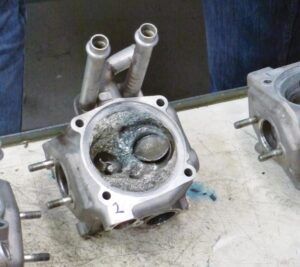
The oil system was first, and this system was one Dean emphasized heavily and often came back to all four days. While you could suffer a complete failure of the cooling system for the cylinder heads and still fly a long time without having the engine seize, the high-revving engine and gearbox literally are bathed in and live or die by a healthy oil system. The dry-sump oil system allows a lower frontal area for the engine and a more compact installation resulting in less drag. The oil system is also one of the primary areas where the engine will be affected by running on 100LL. If used on avgas more than 30% of the time, Rotax reduces the oil-change interval from 100 hours to 50. You can see from some of the photos what lead buildup does to the engine.
As the class went on we quickly got into the guts of the engine. No, you don’t need to bring safety glasses or rubber gloves to keep your hands clean, and Dean was generous with passing around parts to examine and using them to illustrate the system he was talking about, telling the story behind a broken connecting rod or dented piston and how to avoid it happening. Training is also done on a “penguin,” a flightless aircraft that had been damaged in a mishap. The engine mounted to it was also non-flyable, making it a perfect training tool for mechanics to practice on an engine that can run, but will not put lives at risk if someone makes a mistake.
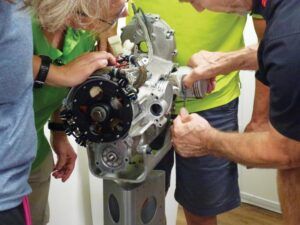
One thing that made me nervous about the Rotax is “balancing” the dual carbs. The Rotax engine has sometimes been called two engines connected by a common crankshaft, and that’s one way to look at it. Each side of the engine has its own Bing carburetor. They must be “synced” or “balanced” so they run at the same rpm and manifold pressure at a given throttle setting. Making this happen was probably one of the biggest horror stories I’d been told about the engine, and Dean made sure that we knew he was going to go over the procedure backward and forward until we had it down.
The need to balance carbs is different than what we’re used to in legacy aircraft engines, but it’s one of the many differences that make the engine more efficient. The Bing carburetor has no separate mixture control; instead, in an elegantly simple design it automatically balances the fuel/air mixture as the airplane climbs or descends. Once the operation of the Bing carburetor is understood, you just shake your head at it and go neat!
The carb sync procedure alone was worth the cost of the course, and as Dean promised we went over it until we all felt comfortable with the procedure. The technique he teaches is proprietary so I won’t be able to explain it here, but I can tell you it took a lot of the anxiety away from me about the procedure. Lockwood also sells the tools to do this procedure, and mine came a few days after I got home. Lockwood also rents tools for 30 days, under the caveat “If you break it, you buy it,” reducing the outlay for mechanics to buy new tools.
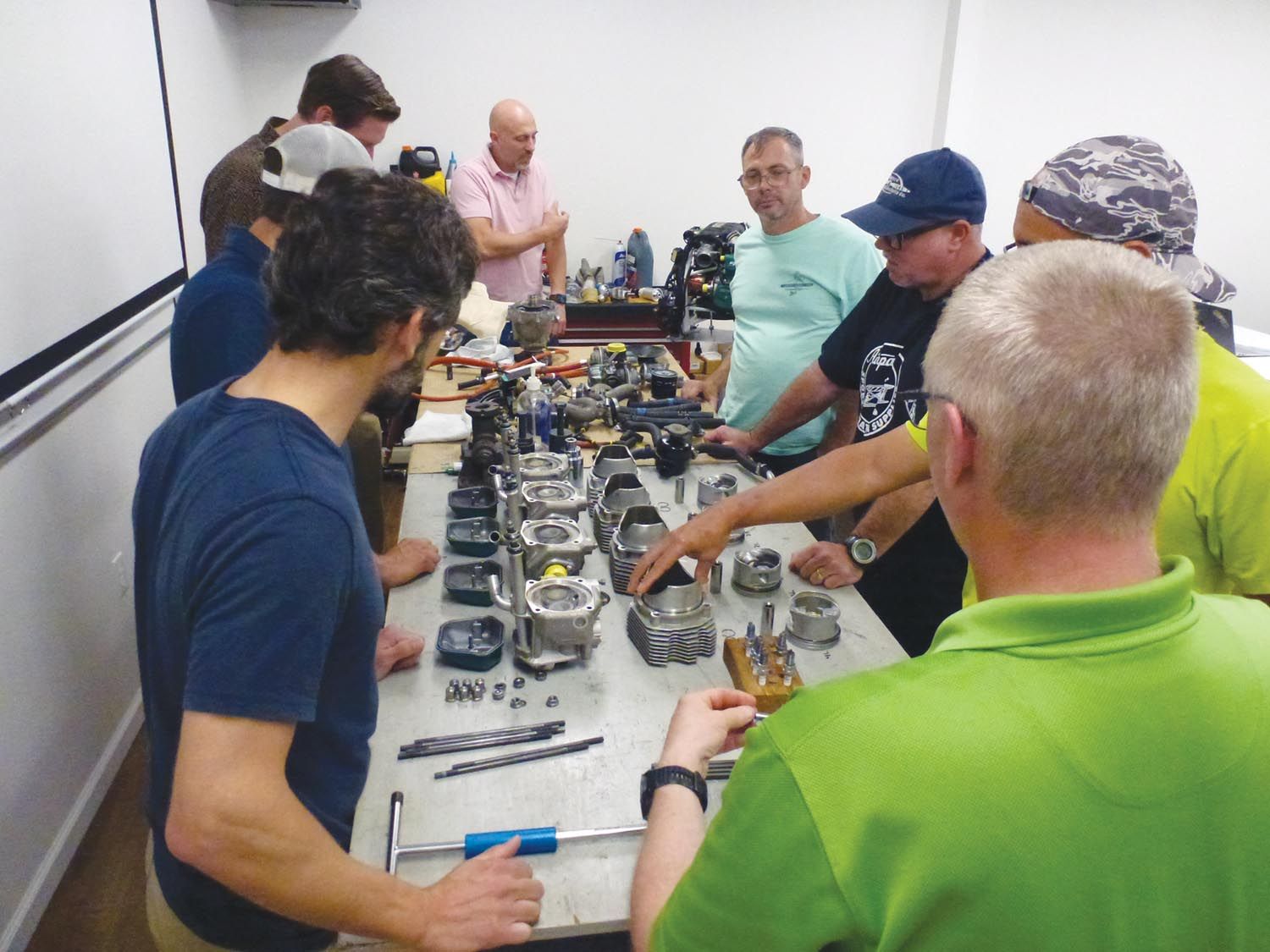
Making Sparks
Another thing different about the engine is that there are no magnetos. Instead, the engine has a large flywheel that is a combination permanent-magnet generator and charging coil, and the timing is permanently set via the position of the trigger coils located just outside of the flywheel. Spark is triggered by a capacitive discharge system, and the plugs fire on what’s called a “wasted spark” system, which means they spark on every stroke, be it a compression or exhaust/intake. This may seem counterintuitive for efficiency, but it eliminates the complexity of timing of having the plug fire every other stroke. (This is also how common electronic ignitions for legacy engines work.)
The third day, as part of the maintenance course, we started off with Dean unrolling a tarp and asking us to try not to get oil on his carpeted floor. Laying out a bunch of tools, he pointed to an engine at the front of the classroom and said, “OK, you’re going to take this apart. Who’s first?” The day was spent dissecting the engine, laying the parts out on the table and giving us an intimate look at everything we had talked and read about during the first two days of the service course, with breaks as we examined the beauty of a finely designed and machined oil pump, for instance, and discussing the strengths and weakness of a particular system.
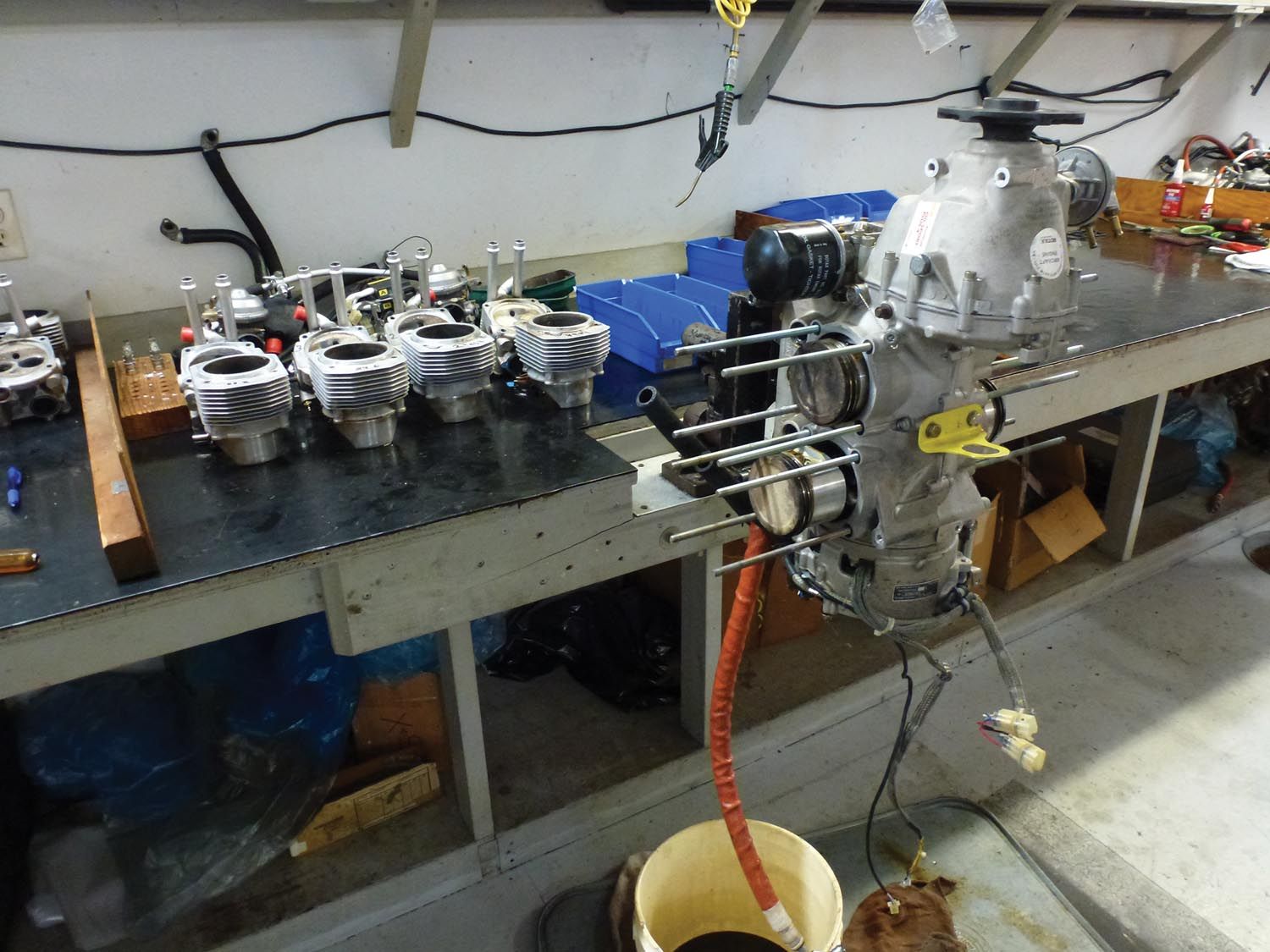
Can you guess what we did on Day Four? Yup, we put it all back together. Because of the rather large hole in the crankcase (another engine that had been abused by an owner), we could not take the engine out and run it, but as a training tool it served its purpose. We got to examine in detail how the engine worked and while I doubt any of us were going to run right out and replace a gearbox or pull a cylinder head, it gave us a considerable insight about how the whole thing tied together.
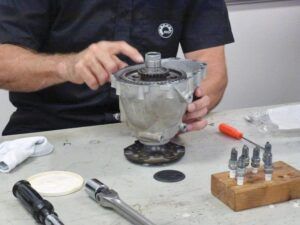
Is the maintenance course necessary for the builder/operator? Nope. You can do just fine not knowing how to pull a gearbox or a cylinder head; in reality most builders would most likely not attempt to do this repair. However, knowing what’s going on inside the mass of gray metal gives you a solid reason why you should (or shouldn’t) do something flying your plane, and it gives us an appreciation for the precise engineering that goes into it. Every procedure is laid out in the manuals, step-by-step with torque values, specific Loctite application and even pictures.
I had debated buying the fuel-injected 912 iS for OspRey but decided not to be the test airplane for the SeaRey community and stay with the proven track of the 914 in SeaReys. So while curious about them, I didn’t stay for the class on the fuel-injected engine. The introduction of the fuel-injected 912 iS, 915 iS and now the 916 iS has many wondering how long carbureted engines will still be produced. There is still a very strong demand for the carb’d 912 and 914, and Rotax has made not a hint or whisper about discontinuing them. With over 50,000 carbureted 912/914s in use around the world they have earned their keep.
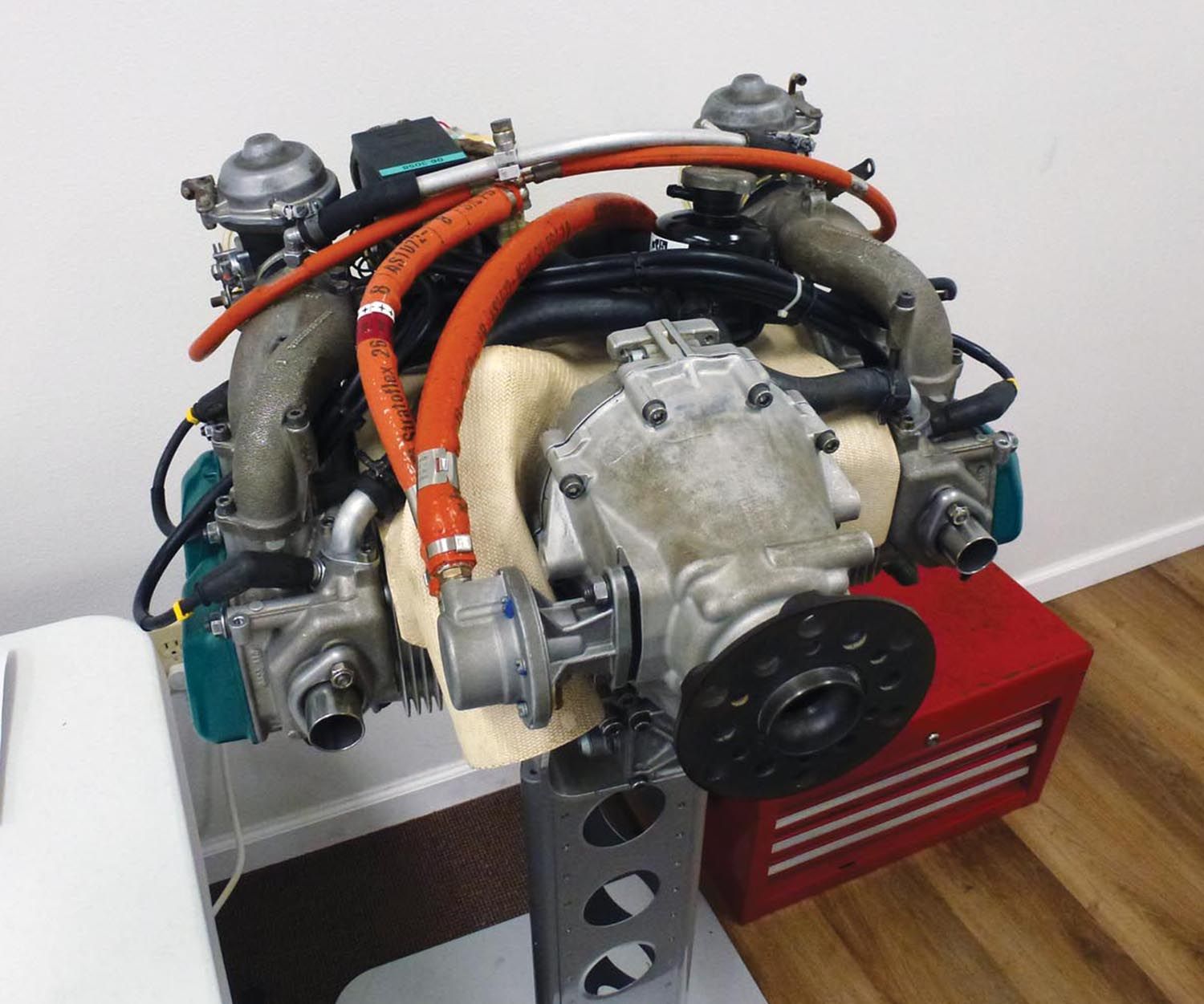
One of the big questions now is how the Rotax engines are holding up. I flew a 912-equipped Katana as a CFI back in the early 1990s, so the engines have almost 30 years of being abused by students and CFIs alike, and there has been continual improvement over the years as the engines have accumulated hours, with the last major one in 2006 when the crankcase had a few design changes. Surprisingly, few flight schools are taking their engines to TBO; instead the trend is for them to sell mid-time engines to homebuilders who are eager to snap up an inexpensive mid-life modern engine—the flight schools just buy new engines. I asked Dean how many engines overall make it to TBO, and he answered “How do you tell? The Experimental guys pay no attention to TBO, they just keep going. So we never see them unless something goes wrong. The Experimental guys who buy new engines might fly 50 hours a year. It’ll take them 40 years to get to operating TBO. I know of 1993 engines that are still going strong. It’s not like I recommend people operate that way, but I know people are doing it.”
The motors are a combination of engineering art, science, and I’m convinced maybe a schmecken of black magic; it doesn’t seem that the tight tolerances in the engines are possible in a mass-produced product but it’s true. I cut my teeth turning wrenches on warbirds and am used to slathering gasket material on, but the one time during the rebuild we did apply gasket material it was put on sparingly, just tapped on with a fingertip so you could see the aluminum through the goo—and even then some of that was squeezed out when the parts were fitted. Incredible machining.
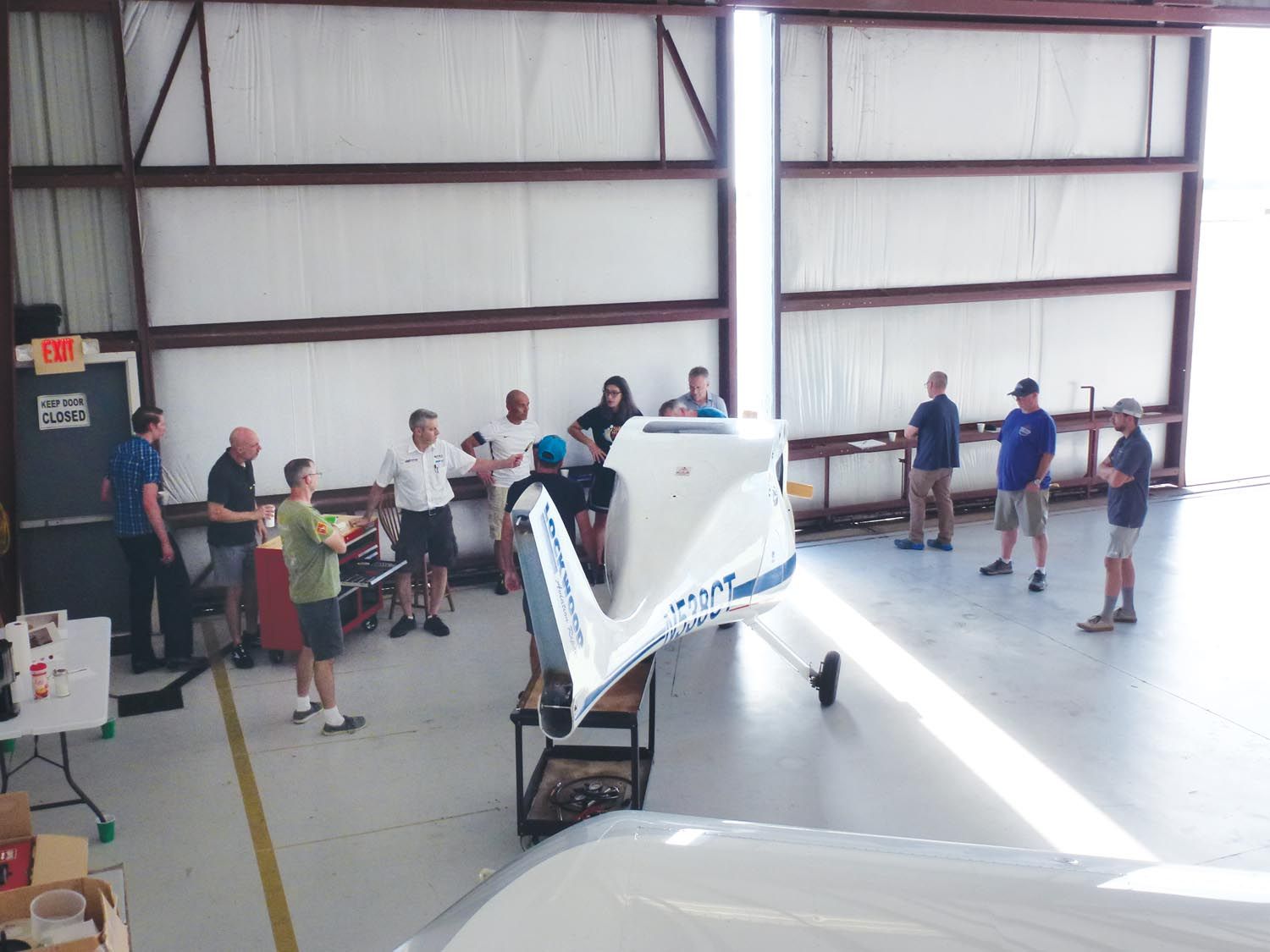
One example of the precision in the engineering is that the piston to cylinder clearance has a tolerance of 0 to 8 ten-thousandths of an inch. That’s less than a human hair. The cylinders have a ceramic coating on the inside—that way the cylinder and the piston can be made from the same material and have the same thermal properties, making this kind of precision possible. You’d think that would make the engine high-strung and fragile, but at the end of the Rotech class when we were running the 914 demo engine, the instructor called me over and had me rapidly run the throttle full travel up and down several times, while I cringed thinking about the rapid heating/cooling effect on the cylinders and turbo. But the instructor chuckled and told us that the liquid cooling protected the head from the temperature cycle, and the engine could do this all day long with no damage.
The class is standardized around the world, so you can rest assured that you won’t miss anything by taking a class at another location closer than Lockwood. I found that taking classes from two separate schools complemented my knowledge, with each instructor and location having their own separate style and training aids. In my case, having bought the engine from Lockwood added to the reasons to take a trip to Florida.
Of course, having bought my engine from Lockwood and being a cheap pilot, I did ask if there was a discount. It’s easy to multiply X number of students by the tuition of the class and think Lockwood is making money hand over fist for a seemingly few days of Dean talking. But remember: You’re not paying for the class; you’re paying for the decades of experience Dean and the Lockwood crew have accumulated and are passing on to you. More than once Dean called me out with SeaRey-specific maintenance or installation instructions, and by the end of the course I lost track of how many potential hours of frustration and thousands of dollars in mistakes Dean saved me.
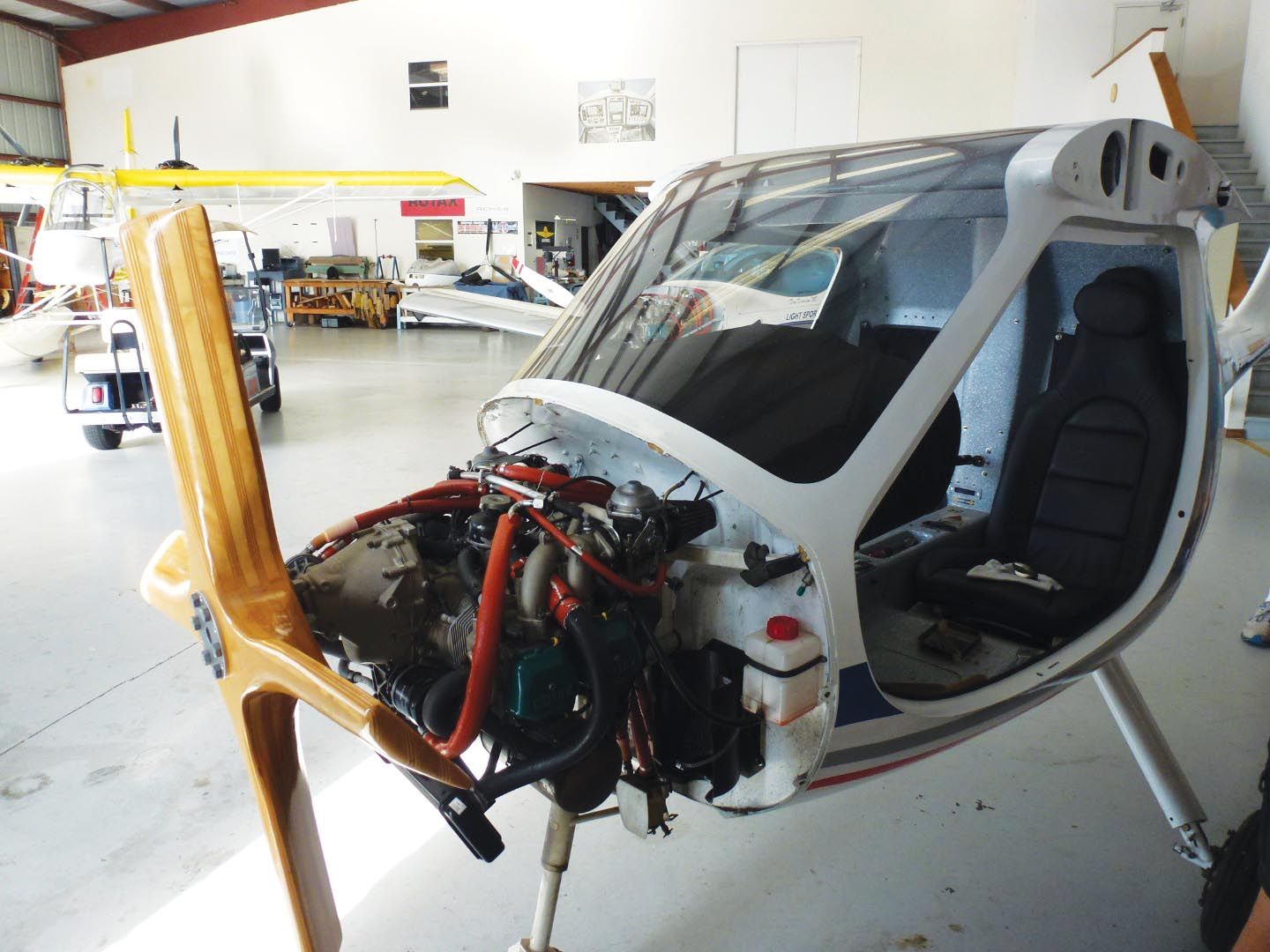
Note that this is not a “gentlemen’s course” where Dean will stomp his foot for something that will be on the open-book, take-home exam. However, he was also willing to help with the more obscure topics, telling us to wait to answer some questions if we can’t find the answer, and we’d probably hear it from his lecture before the exam. The class is not airline ground school intense, but it did remind me of what a friend of mine says about formation flying: It’s not work, but it is very, very hard play.
There’s an old saying that you get what you pay for. Airplanes are an investment of time and money, and the knowledge you get from this class will save you both in the long run. At a minimum, I think any Rotax builder/operator needs to take the service class and, if possible, hang out and do the maintenance one as well.
Oh, how did I do on the test? Well, let’s just say I passed, but I won’t be hanging out a shingle to do work on Rotaxes. What I have, though, is a license to learn.

